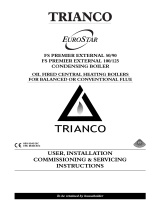
Tigerloop
®
eliminates common oil heating problems.
Burner Pump Problems
Moreover, the presence of air bubbles in the
fuel has some consequences on the operation
of the pump. Diagram 4 is a cut-away of a
pump´s strainer chamber, with the pump
operating normally. The level of oil does not
ll the entire chamber. This is normal because
during bleeding the oil level only rises high
But, if air enters the pump, it will
immediately rise to the top, pushing down
the oil level in the strainer chamber and
partially uncovering the inlet to the gear
set. (diagram 5). The gear set starts
gulping air and oil and the pressure
becomes unstable, resulting in poor
combustion, noise, rumbling, pulsation...
If enough air enters, the oil level drops
completly below the inlet to the gear
set, the pressure is lost and the burner
eventually locks-out. (diagram 6).
The second kind of bubbles are gases
which come from dissolved vapors and
volatiles that are drawn out of the oil when
it is exposed to vacuum. The higher the
vacuum, the more bubbles produced.
Diagram 7 shows what is going on in the
strainer chamber of the oil pump. The
bubbles drawn out of the oil rise to the top of
the strainer chamber, the oil level falls, the
gear set gulps foamy oil, pressure becomes
unstable and the burner eventually locks
out.
Diagram 6
enough to just cover the inlet to the gear set, about two-thirds of the way up the strainer
chamber. This air cushion formed at the top quiets the hydraulic whine of the gear set and
does not affect pump operation. As long as the inlet to the gear set stays covered, all is
well.
The Tigerloop
®
prevents such air/gas problems by automatically and continuously
de-aerating the oil before it enters the oil pump.
Diagram 7
Diagram 4
145 PSI
Diagram 5
115 PSI
0 PSI
115 PSI











